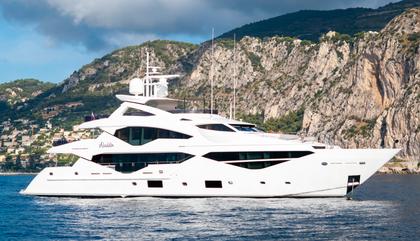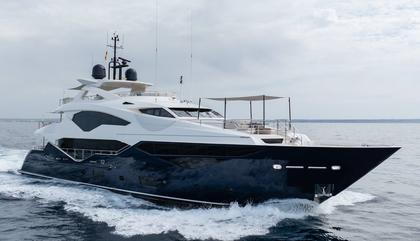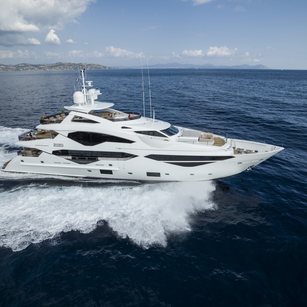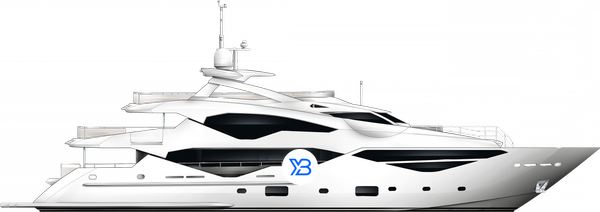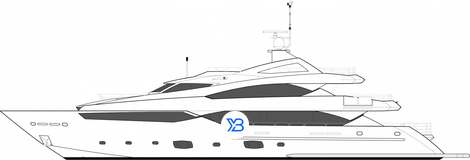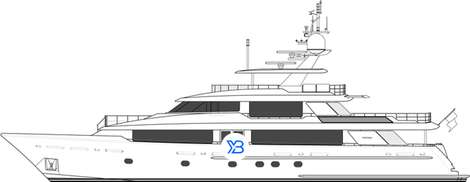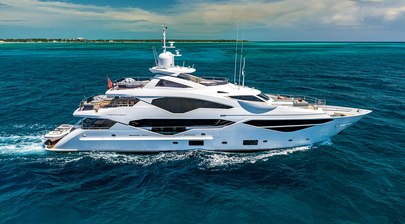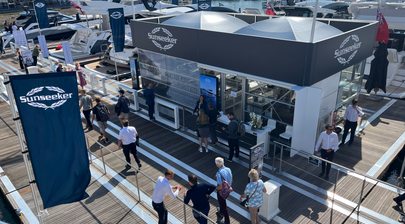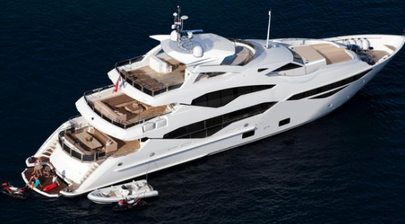-
GenYEARS2016 - 2024BUILT16
Sunseeker 131 Yachts For Sale
The 131 follows on from the Sunseeker 40M, offering the same GRP construction, tri-deck design, five cabins and fast 20-knot performance.
The Sunseeker 131 Yacht is a 40 m (131 ft) raised-pilothouse model designed for owners who want the comfort of a superyacht with the feel of a private boat. Built in GRP by a British yard known for its hands-on approach, it offers a mix of space, pace, and day-to-day logic that still suits both family cruising and light charter use today.
Sunseeker 131 Yacht Buyer's Guide
It holds its ground in today’s market by doing a few things well: five cabins without compromise, crew flow that works, and a layout that hasn’t dated as quickly as some of its rivals. Owners who like to run with regular crew, keep things tidy between seasons, and know where time and cost go often find the 131 fits.
- Why Buy a Sunseeker 131 Yacht?
- Who Buys a Sunseeker 131 Yacht?
- Evolution of the Sunseeker 131 Yacht
- Design & Layout
- Performance & Engines
- Ownership & Running Costs
- Crewing & Operating a Sunseeker 131 Yacht
- Insuring & Registering Your Sunseeker 131 Yacht
- Sunseeker 131 Yachts for Sale: Market Price Insight
- Rivals & the Successor to the Sunseeker 131
- Working with a Buyer's Broker
- Buy Smarter with YachtBuyer
Why Buy a Sunseeker 131 Yacht?
The Sunseeker 131 Yacht holds its worth today because it delivers a fantastic mix of speed, space, and serviceability in a size that stays below the regulatory cliff of 500GT. For owners who want the feel of a big yacht without the sprawl and costs of a 50m, the 131 strikes that balance, backed by a global support net and a deep pool of operational knowledge.
Comfort Where It Counts
- Wide beam and hull shape give unusually roomy cabins
- Decks are smartly split: guests above, crew routes tucked well away for privacy
- Ride is quiet underway and at anchor as floor plates and bulkheads float on rubber mounts
- Large windows in the saloon and master draw the outdoors in, without making the boat feel fragile
Built to Be Run
- Conventional shaft drive and well-known MTU diesels
- Hull design is planing-capable but cruises fine at 10-12 knots for longer legs
- Thrusters and wing stations make tight docks manageable without pods or gimmicks
- Many crew stay on for years
The Upside of Scale
- Sunseeker built 15 hulls: less guesswork, more proven fixes for known quirks
- Support spans the Med, US and Asia
- Known upgrade paths: AV, Wi-Fi, converters, and chillers all have common retrofit playbooks
- Below-500 GT design simplifies flag, manning, and insurance versus next-size-up steel yachts
Why Buy a Used Sunseeker 131 Yacht?
Pre-owned examples often come with stabiliser overhauls, paint touch-ups, and class surveys already done. That can save time and cost during the first few years of ownership. The layout and systems are familiar to most crew and surveyors, which lowers handover risks and cuts down on surprises in upkeep. Also, because of the model's global footprint, buyers can shop across markets and choose based on refit depth, not just how old it is.
A used Sunseeker 131 Yacht gives you the bones and backbone of a superyacht, paired with the running logic of a smart private boat.
Who Buys a Sunseeker 131 Yacht?
The Sunseeker 131 Yacht tends to draw hands-on owners who want a full-size yacht they can still wrap their head around. They like to move at their own pace, value comfort without waste, and often come from boats they’ve run or known well. For some, it’s the first step into full crewed yachting. For others, it’s a sideways move - not to go bigger, but to cruise smarter.
These are owners who like the logic behind the yacht. They respect its balance: how it runs, how it’s laid out, how the upkeep can be forecast. There’s pride in seeing a well-crewed 131 head out with guests aboard and everything in order. Sunseeker built the model for those who wanted a superyacht without the red tape and drag of a steel 50m (164ft) giant. And it found them.
Buyers tend to fall into three groups:
- Private-use owners: Often stepping up from 30-35m (98-115ft) yachts, they use the 131 to cruise with family, invite friends, and stay off-grid for a while – but always with solid backup from shore.
- Charter-savvy investors: These owners run the yacht with a strong crew, keep it tight and well-kept, and treat charter income as a way to offset running costs without cutting corners.
- Second-time Sunseeker clients: Familiar with the brand, they see the 131 as a natural move - it holds the pace, look and feel they know, but gives more space to breathe and entertain.
Many learn the boat teaches good habits - planning fuel, checking stabilisers, keeping the teak sound. It’s not a hands-on boat in the literal sense, but it invites active ownership.
Where the Sunseeker 131 Yacht Spends Its Time
- Western Med: Balearics, Amalfi, and Corsica routes suit its range and size - popular for private trips and high-end charter weeks.
- US East Coast and Bahamas: Draft fits the shallow cruising grounds; shore support for Sunseeker gear is strong from Fort Lauderdale to Nassau.
- Middle East and Asia-Pacific: Owners based in Dubai, Singapore, and Sydney run the 131 for seasonal cruising, often with minor layout tweaks for climate and crew.
Evolution of the Sunseeker 131 Yacht
The Sunseeker 131 Yacht was in production from early 2016 through 2024, with just over 30 hulls completed. There's been no formal generations, but the 131 Yacht saw steady changes over its run. These updates focused on compliance and some owner-led customisation rather than headline design shifts. For today’s buyers, the year of build often signals how far along the updates had gone - and whether the yacht was delivered with newer systems or later added by refit.
Original Launch (2016-2017)
The 131 evolved directly from the earlier Sunseeker 40M, using the same deep-V GRP hull and engine room layout. But Sunseeker redesigned the decks, glazing, and interior flow to meet growing owner demand for more volume, larger windows, and better crew separation. The upper and sun decks were stretched, bulwarks were cut down, and full-height glass was introduced in the saloon and master suite – changes the 40M couldn’t accommodate without major retooling. Most were fitted with MTU 12V 4000 M93 engines, RINA class, and MCA LY3 compliance from new. Sunseeker used a resin-infused GRP hull and superstructure, a wide beam for volume, and pushed hard on noise reduction. Interiors were custom per owner but often featured darker woods and high-gloss finishes. The first dozen or so hulls followed this pattern closely. Buyers comparing early yachts should look for evidence of upgrades as these are often retrofitted rather than factory-standard.
Later Updates (2018-2024)
From late 2018 onward, small but steady shifts appeared. Some owners chose matte woods and lighter palettes. MTU offered the newer 16V 2000 M97L as an option, though few hulls used it. Around this time, frequency converters (for US/EU shore power) and upgraded aircon packages became more common. Stabiliser control units received firmware updates for smoother zero-speed performance. By 2022, most new builds included AV and comms wiring ready for Starlink or similar systems. Refit trends also fed back into new builds - hardtops on the sun deck, gym or massage rooms aft, and crew space tweaks were often factory-integrated if ordered in time. While no structural hull changes were made, the refinements add up. Buyers looking at 2019+ hulls will often find fewer immediate upgrades needed.
When comparing used listings, focus on what’s been updated rather than just age. A well-kept 2017 hull with major refits can be stronger value than a lightly used 2020 yacht missing key upgrades. Systems like chillers, generators, and nav gear often mark the real dividing line in this model’s evolution.
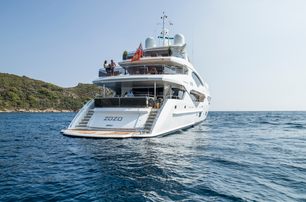
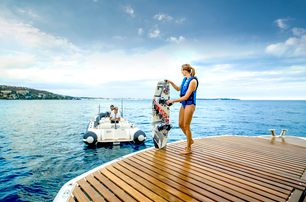
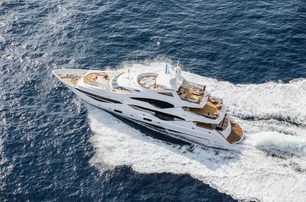
Design & Layout
For a 40m (131ft) yacht, the Sunseeker 131 handles space with logic. It was built to feel like a true superyacht inside, while still keeping clear paths for crew and enough open air for guests to spread out.
On Deck
The sundeck is one of the strongest features. It runs nearly the full length of the top deck, with a forward spa pool, loose sunpads, and a bar that many owners customize - some add fixed stools, others extend the counter to serve buffet meals. Aft space often carries modular seating or loose chairs, which makes it easy to switch between lounging and events. The upper aft deck is shaded, set up for dining, and links cleanly to the sky lounge through wide glass doors. On the main deck aft, there's a more relaxed cockpit space, often used for morning coffee or quiet evenings.
The bow area has a built-in sunpad and ground tackle tucked cleanly forward. Not all guests use it, but it's private and quiet when under way. Side decks are wide enough for safe movement, and stairs are offset to avoid foot traffic bottlenecks. Sunseeker chose not to fit folding balconies - instead, they lowered bulwarks and enlarged windows to keep lines clean while still giving a good view out.
Interior and Guest Accommodation
Most yachts in this series follow a five-cabin layout: a full-beam master on the main deck, two VIPs and two twins below. Twin cabins usually convert to doubles and may carry Pullman bunks for added flexibility. The master is bright and generous, with large windows and a separate office or dressing area. Owners could swap the standard bath layout for one large ensuite with a tub.
The saloon and dining area are open plan, framed by big side windows. Furniture is freestanding and often replaced during refits. The sky lounge above offers a second, more casual indoor space, sometimes set up as a media room or with a bar. Because the galley and crew stairs sit forward and to port, guest spaces feel separate, and there’s little crossover in daily use. Interior finish varies widely: darker gloss woods early on, shifting to matte oak, Wenge, or walnut in later builds.
- Galley variants: Some owners chose an enclosed galley with a dumbwaiter, others opened it up for a country kitchen feel - the latter is more common in US-based yachts.
- Guest layout: Twin-to-double conversion is common, but some early hulls fixed the layout one way. A few yachts include a massage room or gym in place of one cabin.
- Bar locations: Most layouts include a bar in the sky lounge or sundeck; refits often expand these or add new ones aft on the bridge deck.
Tenders and Toys
The 131 carries its tender in a stern garage, launched via the hydraulic swim platform. The standard setup holds a 5.3m to 6.0m (17ft 4in to 19ft 8in) RIB plus two PWCs. When empty, the garage can double as a beach club or gym, though space is limited. Some owners kit it out with storage bins, fold-down benches, or soft flooring. A few yachts moved jet skis to the foredeck or removed one to free up space for dive gear. Cranes and winches vary slightly by hull, depending on tender weight and launch preference.
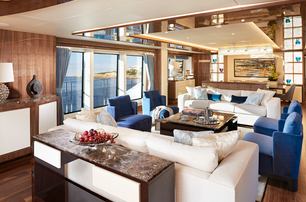


Performance & Engines
The Sunseeker 131 Yacht was built to run fast for its size, without losing the steady ride and quiet trim owners expect from a full-size crewed yacht. The hull lifts onto plane with power, but still tracks well at slower cruise. Most buyers use a mix of fast hops and long slow legs, which suits the hull and engine pairing well.
Engine Options & Specifications
| Specification | Option 1 | Example Option 2 |
|---|---|---|
| Engine model | MTU 12V 4000 M93 | MTU 16V 2000 M97L* |
| Power (per engine) | 3130 hp | 2640 hp |
| Total output | 6260 hp | 5280 hp |
| Top speed | 23 to 25 knots | 20 to 21 knots |
| Cruising speed | 18 to 19 knots | 16 to 18 knots |
| Economical range | 1500 to 1600nm at 10 to 12 knots | Similar, but with lower burn and lower top speed |
| Fuel capacity | 21,650 to 28,600 L (5715 to 7550 US gal) | Confirm on per yacht basis |
| Stabilisers | Stabilizers are common on the 131, confirm on per yacht basis | |
*an engine that can be fitted in the engine room of the Sunseeker 131
The 131 rides on a deep-V hull with sharp entry and hard chines. At slow cruise it tracks straight and feels sure-footed, with little roll thanks to the big stabiliser fins. At higher speed it lifts cleanly without pounding, though in sharp head chop the ride firms up. Owners and crew report low vibration and quiet trim inside the yacht, helped by rubber-floated floors and sealed bulkheads. Engine room access is solid for a GRP yacht, with service points clear and space for two techs to work without crowding. The control room sits aft or offset depending on the hull, and ventilation is strong. Crew appreciate the layout and line of sight from wing stations when docking.
Survey Hot Spots
- Check stabiliser logs and service intervals, especially seals and bearings at 5 to 7 year mark
- Confirm generator hours and top-end work around 10,000 hours on Kohler units
- Look for signs of wear or misalignment at shaft seals and rudder stocks
- Inspect chiller and HVAC systems for recent overhaul or coil flushing
- Review engine heat exchanger and exhaust lagging condition if past 4000 hours
Ownership & Running Costs
The Sunseeker 131 Yacht is steady to own if managed with care and foresight. With a well-documented build spec and strong support from the yard and key suppliers, most running costs follow a known curve. Owners who stay ahead on systems and soft goods tend to avoid sharp spikes and downtime.
Annual Budget Breakdown
- Total yearly cost: Varies with crew, hours, and upkeep strategy, but typically falls within established norms for a 40m tri-deck yacht between 7-12% of the value of the yacht.
- Fuel: Burn rate changes sharply with speed - many owners cruise at 10-12 knots for range, then run fast only for short hops.
- Crew: Most yachts run with 8-9 full-time crew, plus rotation or temp costs depending on program and flag.
- Maintenance: Systems like chillers, gensets, and stabilisers follow known cycles; annual yard work varies by hours and age.
- Insurance & Dockage: Premiums and mooring fees depend on location and usage - highest in peak Med ports and U.S. hubs.
- Refit reserve: Most owners plan for 7-10% of hull value every 5 years to cover paint, soft goods, and mechanicals.
Fuel use climbs sharply above 12 knots, with high-speed cruise often passing 400 litres per hour. A full tank supports slow cruising around 1,500 nautical miles, depending on load. Seasonal dockage is most expensive in the Western Med, with strong demand in Palma, Antibes, and Porto Cervo. U.S. rates peak around Fort Lauderdale and New England. The Bahamas remain workable for draft but offer limited slips in high season. Thanks to steady build numbers and broad dealer support, parts and labour are generally accessible - which helps cut downtime when yard space is tight.
Refit Planning & Yard Rhythm
- Paint and fairing: every 5-7 years, often linked to resale timing.
- Soft furnishings: typical 5-6 year refresh cycle for carpets, covers, saloon finishes.
- Systems: generators, chillers and stabilisers on 5-year overhaul rhythm.
- Decks: teak sanding every 2-3 years; partial replacement every 8-10.
With a predictable service schedule and a stable fleet of sisterships, the Sunseeker 131 Yacht should allow for clear planning. Owners who follow the known yard cycles and log works with care can keep the yacht tight and ready without surprises.
Crewing & Operating a Sunseeker 131 Yacht
The Sunseeker 131 Yacht is a fully crewed vessel, not built for owner-operators. It sits in the light-commercial bracket, under 500 GT, with systems and spaces made for steady pro use. A tight, well-trained crew can run the boat cleanly for either private use or charter.
Most yachts run with 8 to 9 crew, though exact roles flex with itinerary and owner use. The crew mess is placed forward, near the laundry and galley, with separate access routes that keep guest and work paths apart. There are side doors and split stairs that let crew reach the sundeck, bridge, and guest cabins without crossing lounge space.
- Captain: Runs the bridge, logs, port paperwork, and is the main point of contact for the owner or charter manager.
- Engineer: Handles engines, generators, chillers, fuel polishers, and the stabiliser plant – often works solo with shore help as needed.
- Chef: Manages galley kit, provisioning, waste handling, and cold storage – adapts to guest diet or crew meal loads.
- Stews/deck crew: Cross-trained to rotate between guest service, laundry, line work, tender runs, and night watch.
From the helm, sightlines are clean forward and aft thanks to large bridge windows and offset stairs. Thruster controls are smooth and responsive. Most yachts carry wing stations for docking and a camera package for line-of-sight gaps. Stabilisers do most of the work underway and at rest - only rare wind-on-current situations call for anchor snubbing or extra trim tabs.
The bridge has a split-screen helm with radar, depth, engine data, and tank monitors. Shore power, genset, and inverter management runs through a central panel with backup screens. Some yachts upgraded to touchscreen displays and integrated comms for Wi-Fi, VHF, and satlink. There’s redundancy built in for core nav systems, and power switchover is smooth with trained hands.
Legal and Operational Notes
At 40m / 131ft, the Sunseeker 131 is large enough for real sea time but still under thresholds that trigger heavier regulation. The rules below are worth knowing but rarely cause delays in normal use.
- Pilot rules: Most ports require a pilot for yachts over 30m, including parts of France, Spain, and the US East Coast. Some captains secure pilotage exemptions after logged transits, but local rules vary. Good agents are key to avoiding fines or hold-ups.
- Anchoring limits: Marine parks and seagrass zones in Croatia, Sardinia, parts of the Balearics, and southern France restrict anchoring for yachts over 24m. Captains use fixed mooring fields or get drop zones cleared ahead of arrival. In the Bahamas, similar rules apply near coral heads and national park waters.
- Emissions compliance: The 131’s standard MTU 12V 4000 M93 engines meet IMO Tier II, which is accepted for private use in all zones. In some EU and US charter programs, Tier III is now expected for new coding. That may limit charter access in Northern Europe or the Pacific Northwest without retrofit or flag waivers.
- Berthing and marina access: At 40m / 131ft, the yacht fits most Med slips and high-end US docks, but struggles in tight harbours or older marinas built for 35m boats. Reverse mooring with shore passerelles is common in the Med. Some Caribbean islands still lack full-service piers for this size, so captains plan for ship’s tenders and anchorage support.
- Charter coding and flag: Yachts can be coded for charter under MCA LY3, Cayman, Marshall Islands, or similar schemes. The yacht must meet safety, crew, and emissions standards. Some owners also use YET (Yacht Engaged in Trade) status to allow light charter in French waters while retaining private use.
Insuring & Registering Your Sunseeker 131 Yacht
How a Sunseeker 131 Yacht is flagged and insured shapes what it can do - whether it stays private, enters charter, or flips between both. These decisions affect not just cruising routes but VAT, crew rules, safety gear, and resale. Because the 131 sits just under 500GT, it often slips under heavy regulation but still needs careful setup.
Most buyers insure through a mix of standard covers. Good underwriters want to see clean logs, known yards, and tight service records. Class status matters too: RINA or ABS builds from Sunseeker carry more weight than “built to class” only, especially for charter or when placing cover offshore.
- Hull & Machinery: Covers the yacht itself, including damage to gear, systems, and engines.
- Protection & Indemnity (P&I): Covers injury or damage involving other people, crew, or the sea itself (pollution).
- Add-ons: Many owners add cover for tenders, toys, storm risk, personal effects, and loss-of-use claims.
Typical premiums run between 0.8% and 1.2% of hull value per year, depending on age, charter exposure, and prior claims. Later-build yachts with logged class surveys, low chiller hours, and a stable crew history tend to sit at the lower end. Some owners pay more in the first year, then lower premiums once known to the market.
Most 131s are flagged under offshore registries, the most popular being Cayman, Marshall Islands, and Malta. These offer easier charter coding, lower regulatory friction, and smoother resale. A few US-based yachts go under USCG registry, but this can limit charter in foreign waters and complicate crewing rules. For buyers planning global use, offshore flags give more freedom and faster port clearance in the Med, Caribbean, and Middle East.
VAT status matters in the EU. Some yachts are VAT paid, often from first ownership in France or Malta. Others run under Temporary Import (TI), which allows non-EU owners to cruise for 18 months without formal import, but this status must be watched. Using a special purpose vehicle (SPV), often in the Cayman Islands or Delaware, gives clean title lines and can isolate VAT from the sale process. It also helps with financing, resale, and charter revenue reporting.
Sunseeker 131 Yacht Charter Potential
The 131 is often chartered and fits well into the 40m (131ft) bracket for Med and Caribbean seasons. Most coded yachts follow MCA LY3 rules, which set the bar for safety gear, crew quarters, and emergency plans. Coded yachts need approved manuals, fire doors, liferaft racks, and watertight checks. Some early builds needed small upgrades to meet LY3 - later hulls were delivered charter ready. The charter management path varies, but yachts flagged Cayman or Marshall tend to code fastest and cleanest. In the Med, charter is strongest out of the Balearics, South of France, and Croatia. US-coded yachts mostly charter in Florida and the Bahamas but face tighter crew rules and foreign guest caps.
Sunseeker 131 Yachts for Sale: Market Price Insight
The Sunseeker 131 Yacht has remained active on the brokerage scene since its launch in 2016. You can view current listings in the Used Sunseeker 131 Yachts for Sale section, where live asking prices and photos are updated regularly.
How the Sunseeker 131 Yacht Trades
The 131 trades as a single continuous series with no formal generation splits. Listings tend to move based on care and upkeep rather than model year. Clean logs, recent stabiliser work, and fresh AV or paint upgrades count for more than any original spec. A well-run early build can sell as easily as a later hull if the service story is clear and current.
Most Sunseeker 131s remain on the market for just under two years. Sellers who enter the asking price range set by recent deals will tend to draw serious offers faster. Price cuts are modest and often tied to older systems. Across the series, the yachts that sell close to asking are usually the ones with solid records and clean decks.
The data is drawn from confirmed YachtBuyer Market Watch records of sold prices. Read it alongside the live market data and the current price gauges for a real-world view of how the 131 trades today and how values have held over time.
Historic Market Overview
Here you can explore the long-view resale picture through up-to-date price graphs:
- Historic Prices – All Yachts: a single chart showing the trendline of actual sold prices over the past three years, including the sharp shift in late 2023 and the stable band that’s held since early 2024.
Rivals & the Successor to the Sunseeker 131
The Sunseeker 131 Yacht is most often compared to other semi-custom yachts that offer volume and presence without pushing into full-displacement build or steel construction. For data and deeper analysis, see the Sunseeker 131 Yacht Rivals and Head-to-Heads.
Lower-Priced Rival: Benetti Classic 121
The Benetti Classic 121 is shorter overall but shares a similar feel on board, thanks to its high volume and five-cabin layout. It runs on a full-displacement steel hull with an aluminium superstructure, built for range and steadiness rather than speed. Interiors tend to follow a classic, heavier style with smaller windows and tighter crew flow. Some charter strongly, but upkeep varies by hull and refit age. Buyers looking for long passages and softer lines often start here, though paint and systems costs can climb fast on older builds.
Mid-Range Rival: Westport 130
The Westport 130 is a U.S.-built GRP yacht with a loyal following. It runs a little longer than the Sunseeker but is narrower and built to a repeat layout. Interiors are plainer out of the yard but easy to refit. Systems are known and simple to service, with strong yard support stateside. It lacks the glazing and Euro finish of the 131 but trades on build speed and reliability. For owners based in the U.S. or Caribbean, it’s a hands-on, proven option that holds up well if kept clean and current.
Higher-End Rival: Sanlorenzo 44 Alloy
The Sanlorenzo 44 Alloy takes a sharper line in every sense - full aluminium build, drop-down terraces, beach club, and modern cut-glass interiors. It’s faster to the eye, but also to date in upkeep. The design suits owners who prize deck flow and presence over traditional space. Engineering and finish are top class, but so are the maintenance needs. It trades GRP for metal, which can be more custom but potentially more cost over time. Best for those stepping up from full-custom yachts or wanting charter edge with visual punch.
The Successor: Sunseeker 134 Superyacht
The Sunseeker 134 Superyacht picks up where the 131 left off (same GRP build, similar GT) but adds beach club comfort, wider glass, and newer engine options. Its hull trims better at cruising speed, and optional Tier III exhaust kit brings it in line with the latest emission rules. Decks stretch longer, and the interiors shift lighter and more open. Owners who liked the 131’s running logic will find the 134 keeps the bones but sharpens the lines. It drops a bit of top speed in exchange for longer reach and quieter runs.
Working with a Buyer's Broker
A good buyer’s broker checks the yacht, the story, and the seller’s paperwork, not just glancing at a spec sheet. Their job is to help you pick a yacht that fits how you’ll run it, not just how it looks tied up. That means asking all the right questions early: which stabilisers are fitted and when they were last serviced, how many hours are on the main engines and gensets, and whether the logs match the story being told. They’ll flag if a yacht’s been repainted three times in eight years or if the last survey was soft on key areas. With models like the Sunseeker 131 Yacht, they’ll know what to expect, from things like common retrofit gear to where hours typically sit by age.
Good brokers use tools like YachtBuyerPRO to spot weak listings early. That includes checking if a yacht’s asking price tracks with its last sale, how deep the last refit went, and what sister ships have sold for. Historical run-hours, service logs, and refit patterns build a clearer picture of value, and help you steer clear of yachts that look nice but might need some work.
Once talks start, the broker will arrange surveys, book sea trials, and help bring the right eyes on board. After the experts reports come in, they’ll guide the follow-up: repair talks, price adjustments, and contract terms. They keep the deal honest and make sure you’re not the only one walking away with homework. If coding or class are out of date, they’ll find out. If the sale history is cloudy, they’ll dig deeper.
After the deal closes, a buyer's broker stays close. That might mean setting up flag and class, hiring a captain or engineer, booking yard time, or locking down a berth. For buyers coming in from smaller yachts or land-based ownership, this partnership makes a world of difference. With a model like the 131, where many hulls are in charter or ex-charter service, a broker who knows the fleet can make handover smoother, and avoid learning hard lessons.
Buy Smarter with YachtBuyer
Each Sunseeker 131 Yacht has its own path - how it’s been run, maintained and upgraded. Some stayed in private hands, others moved through charter, a few changed flag or spec more than once. Knowing those details before you buy helps you steer clear of guesswork and focus on the right yacht sooner.
YachtBuyer tracks verified sale records, service updates, and refit depth - not just asking prices. With live market data and research-based listings, you can sort real differences in layout, upgrades, and usage. It’s a way to cut through repeat listings and focus on what’s worth your time.
If you’re still browsing, our Video Yacht Tours & Walkthroughs show how the Sunseeker 131 lives and runs - before you step aboard. Clear research and time spent upfront can make ownership smoother later on.
Market Price Insight
Current prices show that a 6-year-old 131 Yacht is available from €13,750,000.
New Sunseeker 131 Yacht - Built to order

Configure Your Own
Sunseeker 134 Superyacht
- Choose color, fabric & specification
- Select your layout
- Warranty & Dealer Support
- Fewer maintenance costs

Used Sunseeker 131 Yachts for sale
View a wide selection of pre-owned Sunseeker 131 Yacht for sale in your area, explore detailed information & find the perfect Sunseeker 131 Yacht for you.
3 Pre-Owned Sunseeker 131 Yachts for sale
Sunseeker
2018 B*****131'ft | 131 Yacht
2 x MTU 3,181hp
Features: Stabilisers, Aircon
Sunseeker
2017 ALADDIN131'ft | 131 Yacht
2 x MTU 3,140hp
Monaco, La Colle, Monaco
Sunseeker
2016 (Refit: 2020) AROHA131'ft | 131 Yacht
2 x MTU 3,140hp
Palma, Balearic Islands, Spain
1 Not for sale to US residents while in US waters
2 Approx Price Conversion
Pictures shown are for illustration purposes only. Actual Yacht may vary due to client options.
LIVE: Used Sunseeker 131 Yacht Prices
Find out how much a pre-owned Sunseeker 131 Yacht may cost based upon the asking price of all yachts currently for sale globally according to YachtBuyer Market Watch & our sales listings.
Market Price Insight
YachtBuyer’s Market Watch reports that there are currently three pre-owned 131 Yachts for sale globally, built between 2016 and 2018. These yachts are listed at prices ranging from $13.9 million to $16.1 million, with an average asking price of $15.2 million. With an average age of eight years, these vessels continue to hold their value thanks to their combination of luxury, performance, and timeless design. However, the launch of the Sunseeker 134 Superyacht in 2027 impacted the pricing of the Sunseeker 131 Yacht, as the newer model introduced updated features, cutting-edge technology, and a more contemporary design that shifted buyer demand. This has contributed to a more competitive pricing range for the 131 Yacht models, highlighting how new Yacht launches influence the market for earlier generations.
Sunseeker 131 Yacht Price
2016 - 2024
- Average Price $15.2m
- Price Range $13.9m - $16.1m
- Average Age 8 years
Recent Sales
-
Model YearLast Asking PriceSold Date
-
2020$13.5mApr-2025
-
2018$15mMar-2025
-
2018$16.1mJan-2025
Members Only Register - it's free
Average asking price according to YachtBuyer data (3 yachts available). Prices may vary depending on specification, condition and extras.
Historic Price Comparison
With seven of the 16 Sunseeker 131 Yachts ever built listed for sale over the past three years, based upon data from to YachtBuyer’s Market Watch, it demonstrates notable activity in its segment. These yachts spend an average of 620 days on the market, reflecting a moderate turnover rate for superyachts in this size segment. Over the same period, the marketed price tends to see a moderate average price reduction of 10.7% from the initial asking price, which demonstrates its ability to hold its value and shows continued interest from the market. Notably, this falls far outside the common range for this size of superyacht, reflecting a less stable position in the market. These yachts have been offered for sale primarily around the west and central Mediterranean, and sometimes the US East Coast.
Sunseeker 131 Yacht Price Trends & Sales Graphs (3-Year Data)
131 Yacht Model Overview & Timeline
Sunseeker first announced the 131 Yacht to the press in 2016 and swiftly went into development and the first model rolled off the production line later the same year. She was unveiled to the general public at the 2016 London Yacht Show where she made her World Debut and made her American Debut at the Fort Lauderdale International Boat Show in 2016.
- Status
- Year
- Length
- Discontinued
- 2016 - 2024
- 131' 5" ft (LOA)
- Beam
- Draft
- Speed
- 26' 6" ft
- 8' 10" ft half load
- 23 Knots
Sunseeker 131 Yacht Awards
Video Yacht Tours & Walkthroughs

2016 Edition
by Aquaholic
Rivals & Head-to-Head
Sunseeker 131 Yacht Rivals
We've hand-picked a series of similar and direct rival yachts help you identify the strengths of the 131 Yacht among its peers. These rivals include the Emirati Gulf Craft Majesty 140 and the Italian Mangusta Oceano 43.
Head to Head
Visually compare everything from performance to layout for these closely matched models from competing builders.
Sunseeker 131 Yacht News
Browse our collection of articles and commentary on the Sunseeker 131 Yacht from Sunseeker.
Sunseeker 131 Yacht FAQ
A selection of frequently asked questions from buyers
-
The 131 Yacht measures 40.06m.
-
The 131 Yacht has a top speed of 23 knots.
-
The 131 Yacht was launched in 2016 and is still in production.
-
Current prices show that a 6-year-old 131 Yacht is available from €13,750,000.
-
Depending on your layout choice, the 131 Yacht can support up to twelve guests in five cabins.
-
The 131 Yacht is a Superyacht
-
To start the process of buying your own Sunseeker 131 Yacht, please get in touch with us or contact a buyer’s broker.
We're committed to making yacht buying easier, so if you can't find what you're looking for just ask.



